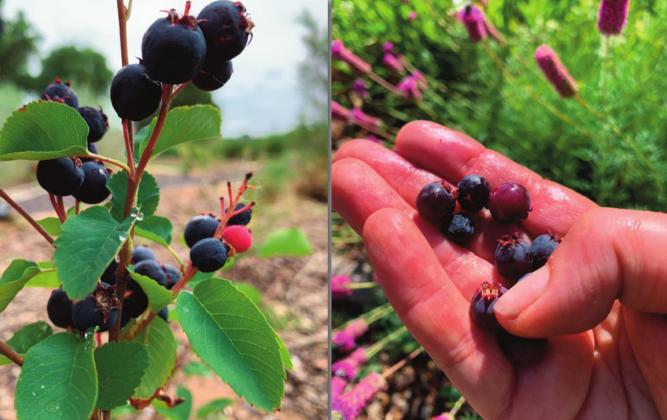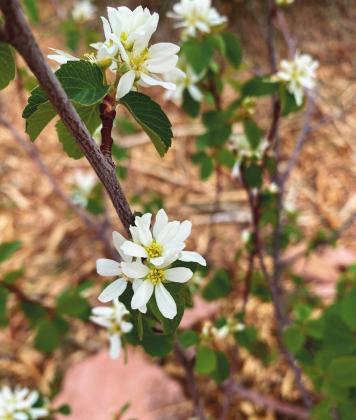In case you haven’t already heard, I have a new favorite fruit—the western serviceberry (Amelanchier alnifolia). Just one fruit. That’s all it took.
Only days before that first taste, I happened across a fun video posted by TikTok creator and forager Alexis Nikole Nelson about a different species of serviceberry found in her Ohio neighborhood. “Serviceberries taste like if apples and blueberries had a baby,” she crooned. My interest was piqued, but it didn’t occur to me that I’d encounter them so soon or so close.
It turns out we have a single western serviceberry specimen at the NMSU Agricultural Science Center at Los Lunas, where I work. In early June, Learning Garden caretaker Carol Bennefield shared a photo of the tiny shrub she had transplanted a few weeks earlier, with a full cluster of ripening berries. Within a few weeks, I came across it myself while watering, and the berries had darkened considerably. Having just seen its cousin featured on TikTok, I put two and two together and gave it a try.
As Nelson pointed out, “Everybody has some sort of connection to foraging because none of us would be here if it wasn’t for that action.” And foraging for fruit is particularly delightful when the flavor is this good. Miraculously, I left half of the cluster on the shrub to be enjoyed later. This week, I shared the last precious handful with volunteers. Together, we decided the berries—which look almost identical to blueberries in shape, size, and color—taste like a cross between an apple and a grape.
Over two dozen species of the serviceberry genus are native to North America. Common names include shadberry, sarvis, Juneberry, chuckley pear, sugarplum, and saskatoon. Robin Wall Kimmerer is an ecologist and author of “Braiding Sweetgrass: Indigenous Wisdom, Scientific Knowledge and the Teachings of Plants,” among other beautifully written books. In a December 2020 Emergence Magazine article titled “The Serviceberry - An Economy of Abundance,” Kimmerer stated, “Ethnobotanists know that the more names a plant has, the greater its cultural importance… In Potawatomi, it is called Bozakmin, which is a superlative: the best of the berries. I agree with my ancestors on the rightness of that name. Imagine a fruit that tastes like a blueberry crossed with the satisfying heft of an apple, a touch of rosewater and a miniscule crunch of almond-flavored seeds. They taste like nothing a grocery store has to offer: wild, complex with a chemistry that your body recognizes as the real food it’s been waiting for.”
I found the western serviceberry listed in several of my favorite regional botany, gardening, and foraging books, including “Southwest Foraging” by John Slattery, Jack L. Carter’s “Trees and Shrubs of New Mexico,” and the Xerces Society guide book “Attracting Native Pollinators.”
The closely related Utah serviceberry (Amelanchier utahensis) is listed in other reputable resource lists, such as UTEP’s Chihuahuan Desert Garden plant list, New Mexico’s Enchanted Xeriscape Guide (published by the Office of the State Engineer’s Water Use and Conservation Bureau), Albuquerque Bernalillo County Water Utility Authority’s “Xeriscaping: the Complete How-To Guide,” and Tree New Mexico’s recent article “Pollinators and Trees.”
Without much experience growing it myself, I was reluctant to recommend the western or Utah serviceberry as a suitable shrub for all parts of the state. I was right to hesitate. While both species are listed as being native to New Mexico, a deeper dig reveals that they tend to be found in higher, cooler elevations—not in the southernmost counties. For a minute, I was excited to find photos of a Utah serviceberry shrub in Dr. Patrick Alexander’s online photo collection (http://polyploid.net/). Alexander is a botanist with the Bureau of Land Management’s Las Cruces District Office and labels every photo with the date and location. Alongside beautiful pictures of the Utah serviceberry flowers, Doña Ana County is reported, but up in the San Andres Mountains, not down in the valley. Alexander describes the plant as “a shrub or small tree, common on shrubby slopes at high elevations in much of the western United States, also found occasionally at moist sites at lower elevations.”
I reached out to Doña Ana County Extension Horticulture Agent Jeff Anderson for his insights. Anderson confirmed that, while it may survive in Las Cruces landscapes, growing conditions are too hot and sunny for the plant to thrive, so it’s not a sustainable option.
In higher elevations above 4,500 ft or so, like areas near the Guadalupe Mountains and the Gila and Lincoln National Forests or north of Elephant Butte, this shrub is one to try if you’re not already growing it. I surveyed Facebook gardening groups to learn more about who’s growing my new fave, where it works best, and what they do with the harvest.
Retired NMSU Irrigation Specialist Daniel Smeal posted that the Utah serviceberries are “very common in San Juan County, but seem to prefer north-facing cliff slopes.” Liz Wallace of Santa Fe commented that hers is growing okay in partial shade, but she intends to move it to a sunnier spot this fall. Several Albuquerque growers reported that the flavor is like a sweeter, nuttier blueberry or mascarpone, and that they’ve never had a chance to preserve the fruit because the berries get eaten before ever making it into the house. It’s no wonder I’m smitten.
For more gardening information, visit the NMSU Extension Urban Horticulture page at http://desertblooms.nmsu.edu/ and the NMSU Horticulture Publications page at http://aces.nmsu.edu/pubs/_h/. Find your local Cooperative Extension Office at https://aces.nmsu.edu/county/.
Marisa Y. Thompson, Ph.D., is the Extension Urban Horticulture Specialist in the Department of Extension Plant Sciences and is based at the New Mexico State University Agricultural Science Center at Los Lunas.


